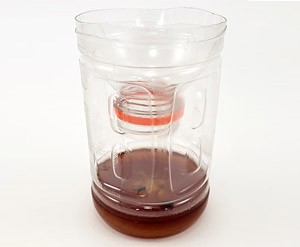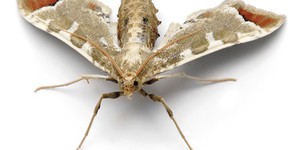Summary
Introduction
Have some pesky flies in your kitchen that you cannot seem to get rid of? In this project you will build your own simple fly trap from a plastic bottle. Get ready to get rid of those flies!
Materials
- Plastic bottle
- Utility knife or scissors
- Sugary liquid like honey, corn syrup, juice, etc.
- Tape
- Adult helper
-
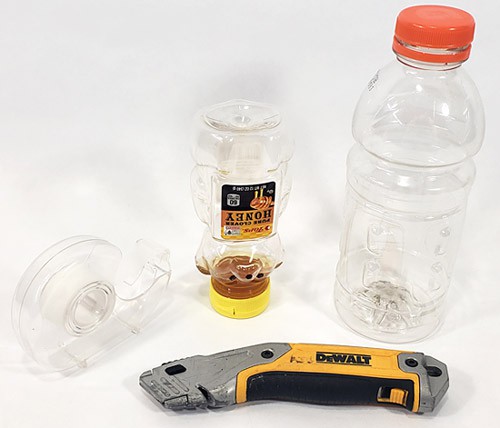 Image Credit: Ben Finio, Science Buddies / Science Buddies
Image Credit: Ben Finio, Science Buddies / Science Buddies
Prep Work
Instructions
- Have an adult help you cut the top part off the plastic bottle.
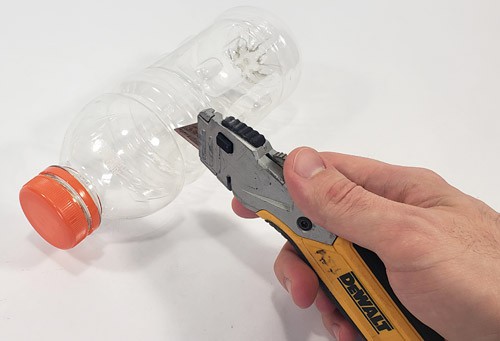 Image Credit: Ben Finio, Science Buddies / Science Buddies
Image Credit: Ben Finio, Science Buddies / Science Buddies
- Partially fill the bottom of the bottle with your sweet liquid.
- Remove the cap, flip the top of the bottle upside down, and insert it into the bottom of the bottle.
- Optionally, tape around the edge to seal the two pieces together. This will make it more difficult for smaller insects like fruit flies to escape through any gaps. However, it will also make it more difficult to empty and clean out your trap.
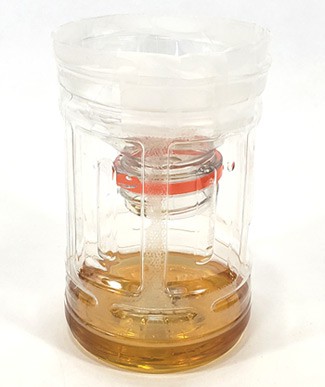 Image Credit: Ben Finio, Science Buddies / Science Buddies
Image Credit: Ben Finio, Science Buddies / Science Buddies
- Let your fly trap sit for a few days in an area where you see a lot of flies. Check on it each day to see how many flies you catch!
- If your trap does not seem to be working, rinse it out and try using a different liquid as bait. You can also use solid food, like rotting fruit or meat, but you will need to add some water so the flies drown. Flies will lay eggs in rotting food—so if you see maggots, get rid of them before you wind up with more flies!
Cleanup
What Happened?
Flies are attracted to the sweet scent of the bait in your trap. The funnel shape made by inverting the top of the bottle makes it easy for the flies to crawl down into the trap, but difficult for them to fly back out. If they try to fly away, they will get stuck against the edges of the bottle. The flies will try to feed on the sweet liquid, but flies are not good swimmers—they will eventually get stuck and drown.
Digging Deeper
You might wonder how flies seem to magically appear out of nowhere. Despite being so tiny, flies have an excellent sense of smell. Just like you might follow the scent of fresh cookies baking in the oven into the kitchen, flies will follow the scents of sugary liquids or rotting foods to the source. They will even notice the smells from outside, and sneak into your house through tiny gaps and cracks to get to the food. The act of using your sense of smell to navigate is called chemotaxis. In this project, the flies followed the smell all the way into your fly trap, and then could not get back out.
Depending on where you live, the time of year, and the type of bait you used, you might have caught different species of flies. Houseflies (the big, black ones) and fruit flies (the really tiny ones) are typically the most common. Humans generally consider flies pests, and they can spread disease since they also feed on animal feces. However, flies are very important for the environment. They help decompose organic matter in nature, and provide a food source for many different predators. So while it is OK to get rid of those pesky flies in your kitchen, we do not want to get rid of all the flies!
Ask an Expert
For Further Exploration
- What bait works best? Build several different traps and put different bait in each one, then leave them all in the same location. Which one attracts the most flies?
- Does the shape of the bottle matter? Compare bottles with different size openings. If the opening is bigger, it might be easier for flies to get into the bottle, but also easier for them to escape.


